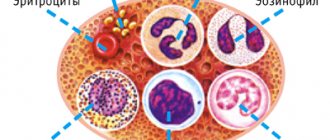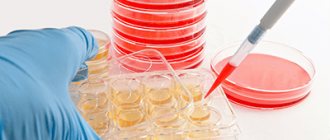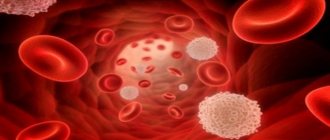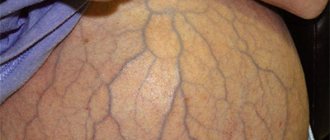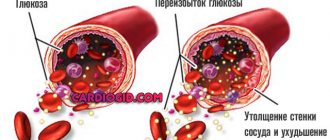Leukocytes, or white blood cells, are part of the immune system. They help protect the body from infectious diseases and are produced in various places in the body, including the thymus, spleen and bone marrow.
Low levels of white blood cells can usually be found in the urine. A high number of white blood cells in the urine (leukocyturia) may indicate an infection or other medical problem.
(c) ProProfs
White blood cells may be present in urine:
Where do leukocytes come from?
The basis of the urinary tract is made up of 2 types of cells: various epithelial and muscle. Their vital activity is supported by capillary blood, bringing oxygen and nutrients. The blood also contains immune cells - leukocytes. They “look around” the urinary tract, checking the “identification marks” displayed on each cell - antigens - with a kind of “list” of such “allowed” molecules.
When white blood cells see the antigens of bacteria, viruses or fungi, as well as the “signs” of cancer cells, they rush to the “compromised” place and begin to destroy foreign agents. After performing their function, they are released into the urine, where they are detected using laboratory tests:
- general (general clinical) analysis - a regular portion of urine taken in the morning. This analysis is the simplest to perform, and it is from it that they usually find out that the white blood cell count is increased (this is called leukocyturia);
- Nechiporenko's test - an average portion of morning urine. It is considered more informative for determining the number of leukocytes, as well as red blood cells and casts in the urine. It better clarifies the number of these cells, which helps in the diagnosis of various inflammatory diseases of the urinary tract;
- Amburger samples. This analysis is performed from 10 ml of urine taken from a container where urine was collected over a 3-hour period;
- Addis-Kakowski test - counting urinary cells in urine collected for 24 hours.
The latter tests are needed to detect hidden leukocyturia (when in a general analysis the leukocytes are normal) or when, after repeated studies, the leukocytes are either elevated or normal. They will help not to miss, but to detect a person’s disease at a stage when an ultrasound will not show anything.
Nutrition rules
Increased attention is paid to nutrition for leukocyturia and pyuria, because the diet helps to quickly normalize the level of white blood cells in the urine. In general, the diet involves following the classic recommendations of therapeutic nutrition.
The best helpers will be products containing large quantities of B vitamins and ascorbic acid. Among them:
- Bulgarian pepper;
- eggs;
- lean meat and fish;
- oranges, kiwi, persimmons, lemons, apples, apricots;
- cereals (buckwheat, barley, oatmeal, wheat);
- dairy and fermented milk products;
- nuts (pine, pecan, hazelnut, walnut);
- Brussels sprouts, cauliflower, red cabbage, broccoli;
- black currant, sea buckthorn, rose hips.
You should exclude from your diet:
- canned food;
- mayonnaise;
- spices, hot, tart seasonings;
- spicy, salty and fatty foods;
- smoked meats, sausages, semi-finished meat products;
- sweet.
You should definitely take care of your drinking regime in order to thoroughly flush the kidneys and urinary tract, preventing congestion. Not only fresh, clean water will help here, but also fruit drinks (especially cranberry), infusions and decoctions of medicinal herbs, and herbal teas.
Leukocyte norm
Normally, there may be several immune cells in the urine: these are the “sentinel” cells that check the organs for infection or cancer. In women, a little more of these cells are allowed: those leukocytes that “check” the genitals can also enter their urine.
- So, the norm of leukocytes in the urine (according to general clinical urine analysis): in women: 0-6 in the field of view;
- in men: 0-3 in the field of view.
So, what does “increased white blood cells” mean? Depending on what urine test they are determined by, these are:
- or more than 3 in men and 6 in women (according to general analysis);
- or more than 2000 (according to Amburge and Nechiporenko);
- or more than 2 million (according to Addis-Kakovsky).
Normal in children
In infants, in relation to the amount of “work” performed, leukocytes are somewhat “weaker”. This means that the norm of leukocytes at the age of up to one year is different: from 1 to 8 cells/field of view. This amount in the urine of a baby may increase during periods of teething, when non-microbial inflammation of the tooth socket occurs, and many leukocytes are forced to enter the urine.
In older children, the norms approach those of adults. To assess whether your child's reading is normal, there is a table by age. You just need to compare the resulting general urine analysis with it:
| Age | Normal in sight | |
| in boys | in girls | |
| up to 28 days of life | 5-7 | 8-10 |
| up to a year | 5-6 | 8-9 |
| from 1 to 18 and older | 0-5 | 0-6 |
Thus, the fewer leukocytes in the urine, the better. Some practicing urologists express the opinion that if more than 3 leukocytes in the field of view are determined in the urine of a child of any age by a general clinical method, then he should already be examined according to the algorithm given in the section “What to do if there is an increase in leukocytes in the urine.”
Diagnosis of the problem
As a rule, the pathological condition is detected by TAM. If the analysis reveals an increase in leukocytes, then the woman is given a referral for a clarifying urine examination according to Nechiporenko.
If deviations from the norm are detected in the control analysis, then further diagnostic measures will be aimed at identifying the cause of the disease.
- Urine analysis according to Zimnitsky. The technique is necessary for diagnosing developing pyelonephritis.
- Bacterial culture of urine. The analysis helps to select the appropriate drug to combat the pathogen.
- CBC and blood for biochemistry. Allows you to evaluate ESR, the number of leukocytes and hemoglobin in the body. Indicators suggest the presence of certain diseases.
If there are no pathogenic microorganisms in the urine, then the woman is given a referral for a vaginal smear. In sexually transmitted diseases, germs are not sown in the urine.
Types of leukocyturia
By origin, leukocyturia is:
- true when the causes of increased leukocytes in the urine are diseases of the urinary system;
- false, when leukocytes enter the urine from the genital tract (to determine inflammation in the genitals, leukocytes are determined in a smear from them). This can occur in both men and women of any age. The cause of this condition can be either poor hygiene of the genital organs before the test, or inflammation of the external genitalia in women (vulvovaginitis) or the skin of the penis and its head (balanoposthitis).
There is another classification that takes into account the sterility of urine, in which a large number of leukocytes are found. In this case, leukocyturia occurs:
- infectious. Caused by inflammation of the urinary tract. During bacterial culture or PCR testing of urine, a microbe is identified.
- non-infectious (aseptic). It is caused either by non-infectious processes (for example, autoimmune glomerulonephritis or allergic cystitis), or by inflammation occurring in organs adjacent to the urinary tract, or by taking the drugs listed below.
Depending on the quantitative results shown by a general urine test, leukocyturia can be:
- minor: 7-40 leukocytes per field of view;
- moderate: 41-100 cells per field of view;
- severe (it is also called pyuria, that is, “pus in the urine”), when more than 100 cells/in the field of vision are determined.
Depending on which leukocytes predominate in the field of view (leukocytes are a collective concept for several types of cells), leukocyturia can be neutrophilic, lymphocytic, eosinophilic and mononuclear. Each of them is characteristic of certain diseases. To determine the type of leukocyturia, an additional urine test is required: this indicator is not determined by a standard general clinical analysis.
Prevention
To reduce the likelihood of disease, you must adhere to basic recommendations:
- have one sexual partner;
- take a general urine test twice a year;
- Always maintain personal hygiene and change your underwear every day;
- if you have several sexual partners, use condoms;
- exercise and eat healthy foods;
- After each urination, use antibacterial or dry wipes to remove any urine remaining on the genitals.
Even with a slight increase in leukocytes in the urine, it is worth insisting on additional analysis and, if possible, an ultrasound of the kidneys. If the result is again higher than normal, hospital treatment may be required.
Causes of increased leukocytes in urine
An increased level of leukocytes can be determined not only during illness. This can be due to insufficient genital hygiene (read how to properly prepare for urine donation, below), as well as due to taking certain medications. The latter include:
- diuretics;
- antituberculosis drugs;
- some antibiotics;
- drugs that suppress the immune system (used in the treatment of autoimmune diseases, tumors, and also after organ transplantation);
- non-steroidal anti-inflammatory drugs, which are usually used to treat pain syndromes of various localizations.
Let's consider when more than 6 leukocytes appear in the urine in the field of view in people of both sexes:
For cystitis - acute and chronic
An acute disease is difficult to miss: it is manifested by intense pain in the lower abdomen, a strong urge to urinate and its pain (especially at the end), sometimes also the release of blood in the urine and an increase in temperature. But chronic cystitis can be asymptomatic, only in some cases making itself known by frequent urination and slight discomfort with it. With chronic cystitis, exacerbations periodically occur, which manifest themselves as symptoms of an acute process.
For urethritis - acute and chronic
Acute inflammation is manifested by pain, especially severe at the beginning of urination, increased frequency and cloudiness of the urine. With chronic urethritis, these symptoms appear only occasionally, after hypothermia, drinking large amounts of alcohol and sexual intercourse. The rest of the time, the disease may not show any symptoms.
Pyelonephritis, pyelitis
For pyelonephritis and pyelitis, which are acute and chronic; have the same manifestations. Acute inflammation of the kidney tissue is characterized by high fever, symptoms of intoxication and lower back pain. Chronic pyelonephritis can only manifest itself as faster fatigue, periodic headaches and fevers below 38°C. Your lower back may also feel like your lower back is freezing faster.
Urolithiasis, tumors
Leukocytes can be detected when blood enters the urine (it contains all the blood cells), which happens with urolithiasis (when a stone injures the urinary tract), after injury to the kidneys or descending urinary tract, when there is a tumor in the kidneys, prostate or descending urinary tract . And if urolithiasis usually manifests itself with symptoms of renal colic (sharp and intense pain in the lower back, radiating to the genital organs), and the fact of injury itself is difficult to forget, then tumors of the genitourinary system do not have any symptoms for a long time.
Glomerunonephritis
With glomerulonephritis, that is, inflammation of the renal glomeruli, which does not occur due to infection of the kidney tissue (as with pyelonephritis), but with a strongly “active” immune response to the microbial inflammation present in the body. Glomerulonephritis can also be autoimmune in nature, when the cells of one's own immunity begin to attack the glomeruli of one's own kidneys. Acute glomerulonephritis is manifested by increased temperature, weakness, decreased appetite, nausea, and the appearance of swelling on the face, which is greater in the morning and less in the evening. In some cases, blood appears in the urine, which gives it a brown, black or dark brown color.
With pyonephrosis
This is the name given to the melting of kidney tissue when an abscess forms; is a complication of pyelonephritis. Manifested by weakness, sleep disturbance, increased sweating, pain in the lumbar region.
With paranephritis - inflammation of the perinephric tissue
It is a complication of pyelonephritis, bacterial inflammation of the colon, which comes into contact with this fiber, as well as purulent pathologies of other organs, from where bacteria are spread throughout the body through the blood. Manifested by increased temperature, pain in the lower back and half of the abdomen.
For renal cysts
For a long time, until the cyst disrupts the flow of urine, they do not manifest themselves in anything. As soon as urine flows poorly, it begins to stagnate in the kidney, and a bacterial infection occurs here. This is manifested by fever, lower back pain, and weakness.
For renal amyloidosis
This is a disease characterized by the deposition of a special protein - amyloid - first between the main “working elements” of the kidney, and then with the replacement of these structures. As a result of this pathology, normal kidney tissue is largely replaced by non-functioning pink shiny tissue. The disease occurs due to hereditary disorders of certain genes. It also develops with chronic infections, tumors, and autoimmune diseases.
Renal amyloidosis does not manifest itself for some time (3 years or more), then protein, red blood cells and white blood cells begin to be lost in the urine, resulting in swelling and the skin becoming pale. At the next stage, even more protein is lost, because of this, swelling on the body also increases and stops responding to diuretics. Blood pressure may be increased, normal, or decreased. Shortness of breath, dizziness, weakness develop; the heart function is disrupted, the amount of urine decreases.
For kidney tuberculosis
It can develop as a complication of pulmonary tuberculosis or without changes in the lungs. It manifests itself as weakness of varying degrees, an increase in temperature to low numbers, pain in the lower back, cloudy urine, in which blood is sometimes visible to the naked eye. If kidney tuberculosis is complicated by bladder tuberculosis, the same symptoms are observed as with non-tuberculous cystitis.
Appendicitis
With appendicitis, when the inflamed appendix lies on the bladder, leading to reactive inflammation of the latter. By the way, appendicitis is not always acute, which is very difficult to miss. In some cases, the disease takes a chronic course, manifested by periodic pain in the lower abdomen and on the right, which intensifies with physical activity; nausea, bloating; constipation or diarrhea.
For allergic diseases
For allergies caused, among other things, by waste products of parasites. Changes similar to those observed in the skin (urticaria) or nasopharynx (allergic rhinitis), with severe allergies, appear in the intestines and urinary tract. As a result, the mucous membrane of the urinary tract, inflamed under the influence of histamine, becomes a source of leukocytes.
For diabetic nephropathy
If a person has diabetes, he needs to monitor not only the level of glucose in the blood, but also a general urine test. The appearance of leukocytes here indicates that due to long-term maintenance of a high sugar concentration, the vessels feeding the kidneys have been damaged, which is why the tissue of the latter suffers. This is diabetic nephropathy.
With systemic lupus erythematosus, then this complication is called lupus nephritis
Systemic lupus erythematosus can be suspected by the appearance of characteristic redness on the face in the area of the cheeks and bridge of the nose (reminiscent of a butterfly), “strange” rises in temperature, muscle and headaches, hair loss in patches, and brittle nails. The fact that nephritis has developed is indicated by swelling that appears on the face, legs and feet, the appearance of lower back pain, and increased blood pressure.
For rheumatoid arthritis
In this case, the joints are the first to be affected in varying numbers and combinations. The joints in the hands are almost always affected. Kidney damage is manifested by swelling of the face and legs, a decrease in the amount of urine, and an increase in temperature.
When dehydrated
Then there is either excessive sweating (including at high body temperature), or diarrhea, or blood loss, or the discharge of large quantities of urine.
For diseases accompanied by severe intoxication
These are mainly infectious diseases: severe sore throat, pneumonia, leptospirosis.
Elevated leukocytes in urine in women
Additionally, leukocyturia in women develops due to “false” reasons, that is, associated not with the kidneys or with the body as a whole, but with diseases of the female genital organs. This:
- Vulvovaginitis (inflammation of the vagina and external genitalia), including candidiasis. It usually manifests itself as discomfort in the vulva and vagina, sometimes with itching; Discharge of different colors and characters appears from the vagina, depending on the pathogen. So, with candidiasis (thrush) it is usually curdled leucorrhoea.
- Bartholinitis (inflammation of the Bartholin gland at the entrance to the vagina). The acute process is manifested by the appearance of swelling and pain in the genital area, which intensifies when sitting, walking, sexual intercourse, or visiting the toilet; one labia majora becomes extremely painful to touch. Also, with acute bartholinitis, body temperature rises to high levels, weakness and chills appear. With chronic bartholinitis, periods of remission without symptoms are replaced by the appearance of a painful, compacted area in the labia majora, which is accompanied by pain when moving. Body temperature may rise, but to low levels.
- Adnexitis is an inflammation of the uterine appendages, which can be either unilateral or bilateral. Acute adnexitis is difficult to miss. This is pain on one side of the abdomen, radiating to the rectum and sacrum, fever, weakness, and the appearance of purulent or copious mucous discharge from the vagina. If the disease is not treated, it becomes chronic. Then menstrual cycle disorders come to the fore, and periodically the same symptoms appear as during an acute process, but less pronounced.
An increase in leukocytes in the urine during pregnancy above 9-10 cells in the field of view cannot be a sign of normality. It indicates that one of the pathological processes discussed above has appeared in the woman’s body. Most often, pregnant women may develop cystitis (chronic cystitis often worsens) or pyelonephritis. Both of these pathologies are associated with the fact that the urinary tract is compressed by the growing uterus, and urine stagnation occurs in it.
Leukocytes in urine during pregnancy can also increase due to thrush of the genital organs, which often worries a woman due to a decrease in immunity that is natural during pregnancy. But the most dangerous reason for such a change in the general urine test is gestosis in the 2nd half of pregnancy, when the kidneys suffer from the fact that the body perceives the fetus as a foreign organism. In this case, not only leukocyturia is necessarily noted, but also an increase in protein in the urine. In this case, hospitalization in an obstetric hospital for further diagnosis and treatment is mandatory, since gestosis is life-threatening for both mother and child.
Symptoms
A significant increase in leukocytes in women is a characteristic sign of a number of genitourinary diseases, during which the following clinical manifestations of pathological changes in the body may occur:
- high blood pressure;
- nausea and vomiting;
- nagging pain in the lumbar region;
- pain in the lower abdomen, in the pubic area;
- increased body temperature;
- blood in the urine;
- disruption of the normal process of urination (frequent, delayed, accompanied by severe pain and pain, a feeling of incomplete emptying of the bladder).
In addition, during general clinical blood tests, leukocytosis, a high level of ESR, and an increased concentration of proteins (CRP) are detected, which in itself confirms the presence of inflammation. The appearance of the urine itself indicates illness: the color is changed (brown, greenish, the color of meat slop, milky white), there is a lot of turbidity and suspension in the urine.
Elevated leukocytes in urine in men
If a man has more leukocytes in his urine than necessary, then in addition to the reasons listed above, which are characteristic of both sexes, this may be:
- Prostatitis. When this is an acute process, it manifests itself as painful urination, while the pain is localized in the sacrum and perineum and intensifies during defecation. The temperature rises, and when the process is far advanced, the outflow of urine becomes difficult, and erectile function suffers. With chronic prostatitis, only slight discomfort or mild pain may be felt when urinating; The temperature periodically rises to very low numbers. More often the disease occurs without symptoms.
- Phimosis - fusion of the opening of the foreskin - is difficult not to notice: in an erect state, the head is not completely exposed or cannot be exposed at all. In the severe stage, urination is also impaired: urine first swells the sticky foreskin, and then flows out drop by drop from the resulting “bag”.
- Balanoposthitis is an inflammation of the skin covering the penis, usually spreading to the head. It manifests itself as painful sensations in this area, itching and burning, increased temperature, the appearance of discharge, increased libido due to irritation of the head, high body temperature.
- Prostate adenoma does not appear for a long time - until the prostate enlarges so much that it begins to block the outflow of urine. Later, its symptoms include a decrease and intermittency of the urine stream, forced strain at the beginning of urination, which is later replaced by pain. When, due to compression by an enlarged prostate, the bladder stops emptying completely, a man is bothered by a frequent and strong urge to urinate; I have to get up to go to the toilet several times even at night. If complications arise, blood appears in the urine, and either urinary incontinence or complete retention develops.
- Prostate cancer symptoms are no different from prostate adenoma. If a man does not undergo routine examinations by a urologist or ultrasound, and the cancer reaches the stage where metastases appear, pain in the bones or spine, cough (if metastases in the lungs), weakness and icteric discoloration of the skin (if metastases in the liver) appear.
Elevated leukocytes in urine in children
When more leukocytes are detected in a child’s urine than normal, these may be for the same reasons as in adults, with the exception of processes such as prostatitis, adenoma and prostate cancer in boys. Amyloidosis, tumors (benign and malignant) and cysts of the urinary tract are rare for children.
Each child’s age is characterized by a different set of diseases accompanied by leukocyturia:
- Before one year of age, some severe congenital malformations of the urinary tract, drug-induced kidney damage, and vesicoureteral reflux (reflux of urine from the bladder into the ureters) begin to appear. Leukocyturia can also appear with diaper rash, as well as when a child has diathesis (in children with diathesis, the norm of leukocytes in the urine is 2 cells more than in peers without this allergic disease). Girls at this age may already have vulvitis, then even with the naked eye parents can notice redness and swelling in the area of the labia minora and the vestibule of the vagina.
- When the child is one year old , leukocytes indicate enterobiasis (pinworms), inflammation in the urinary tract: urethritis, cystitis, vesicoureteral reflux, and, less commonly, glomerulonephritis. In girls, this may be a sign of vulvitis.
- Up to 3 years, the main causes of leukocyturia are: enterobiasis, kidney injuries, vesicoureteral reflux, urinary tract infections, including pyelonephritis. They, appearing for the first time at this age, often become chronic, and if not treated correctly can be complicated by pyonephrosis. In boys at this age, phimosis debuts.
- From 3 to 5 years, leukocyturia can indicate enterobiasis, urolithiasis, urethritis or cystitis (more often), pyelonephritis (less often), kidney injury, glomerulonephritis. Girls have vulvitis, boys have balanoposthitis.
- Age from 5 to 11 years is typical for urolithiasis, urinary tract infections, acute appendicitis, kidney injuries, glomerulonephritis. If there was mild vesicoureteral reflux, then at 6-7 years old, on the contrary, it can heal on its own. At this age, enterobiasis can also occur, causing leukocyturia.
- In children over 12 years of age, the causes of leukocyturia can be all those diseases that are characteristic of adults. As already mentioned, with the exception of tumor diseases, diabetic nephropathy, amyloidosis.
Therapeutic approach
Treatment and correction of leukocyturia directly depends on the cause that led to it. Only a specialist can determine it and develop appropriate therapeutic tactics, so in no case should you self-medicate.
Attention! Ignoring the problem and postponing a visit to the hospital in many situations accompanied by an increase in the level of leukocytes can lead to a significant deterioration in the patient’s condition.
The very first thing to do is a comprehensive examination that will help establish a diagnosis. This may include both laboratory and instrumental techniques. If a bacterial infection is determined, then antibiotics are prescribed in the form of tablets (in severe cases in injection form), such as Ampicillin, Tetracycline, Ceftriaxone, etc. If necessary, vaginal suppositories or bladder lavage are prescribed.
If a viral infection is detected, antiviral drugs are used. In addition, symptomatic treatment is prescribed. The allergic reaction is relieved by using antihistamines - Diphenhydramine, Suprastin.
In case of reduced immunity, it is recommended to take medications to stabilize it or adjust the diet. Identified neoplasms of a benign or malignant nature are treated with surgery and subsequent radiation or chemotherapy.
If, based on the results of a comprehensive diagnosis, no pathological processes were diagnosed, then therapy is not prescribed, and the woman is recommended to undergo further examinations over time in order to monitor her condition.
If an infection is detected in the genitourinary tract, antibiotics are prescribed in most cases.
It should be noted that minor leukocyturia diagnosed during pregnancy and after delivery does not require specialized therapy, and the doctor, as well as the woman herself, is only required to monitor the state of health. Otherwise, there is always a chance of missing the onset of the development of any pathology.
If the increase in the indicator is caused by taking medications, then you need to notify the doctor about this, and he will prescribe analogues that do not affect the composition of urine or reduce the dosage of the drug.
What to do if there is an increase in leukocytes in the urine
There is a special algorithm of actions that must be followed in order to establish the cause of leukocyturia:
- Perform a thorough toileting of the external genitalia, as described in the section below, and only then take a general urine test again.
- If the second analysis is normal, doctors recommend not to calm down, but, with prior agreement with a nephrologist or urologist (especially if it concerns a child), to collect urine during the day for the Addis-Kakovsky test. Only if it is the norm there, you can do nothing further.
- If in the second urine test the number of leukocytes is again increased, even if it is a figure of 3-5 cells, 2 tests are needed: urine culture (for this, urine must be given after genital hygiene and always in a sterile jar) and a three-glass sample. Based on bacterial culture data, it is possible to determine which pathogen caused the inflammation, and based on the data of a three-glass sample, its localization can be established.
The three-glass test is most often performed in a hospital to avoid errors, but can also be performed at home. It requires 3 identical clean containers, which are numbered accordingly: “1”, “2”, “3”. After hygiene of the genital organs, you need to start urinating, but do it in such a way that very little urine (1/5) gets into the first glass, the maximum amount (3/5) into the second glass, and the last few drops (1/5 of the volume) into the third glass. .
Next, 3 glasses are sent to the laboratory, where the number of leukocytes in each of them is counted. Next they reason like this:
- if the maximum number of these cells is in jar No. 1, then this is urethritis, vaginitis or enterobiasis;
- if the maximum number of leukocytes is in sample No. 3, then this indicates prostatitis or inflammation of deeper tissues in the pelvis;
- if there are a lot of cells in all three samples, it means inflammation either in the kidneys or in the bladder.
Besides:
- If, during a three-glass test, leukocytes are increased in all samples, an ultrasound scan of the kidneys and bladder is performed. Next, determine which organ is inflamed. If, according to ultrasound, it is the bladder, x-ray cystography is performed. If, according to ultrasound data, it is the bladder, you need to do urography or renoscintigraphy.
- If, when conducting a three-glass test, the maximum number of leukocytes is in the first portion, the following tests are needed: imprint for enterobiasis in persons of both sexes; for men - a smear from the urethra, and for women - a smear from the vagina. Both smears must be sent to a bacteriological laboratory.
- During a three-glass test or a separate study, it is necessary to determine the shape of leukocytes: if the majority of leukocytes are neutrophils, this indicates: pyelonephritis, cystitis, urethritis, acute glomerulonephritis, or exacerbation of chronic glomerulonephritis. Special staining with gential violet and saffronin will partly help to distinguish pathologies. It can detect Sternheimer-Malbin cells (active white blood cells). If there are many of them, this speaks in favor of pyelonephritis;
- if the majority are mononuclear cells. They are determined in the later stages of glomerulonephritis, as well as in interstitial nephritis;
- when there are a lot of eosinophils, then with a negative urine culture this is an excellent help to the doctor. So he learns that the cause of leukocyturia is allergic diseases;
- if the majority of cells are lymphocytes, this indicates lupus or rheumatoid nephritis, glomerulonephritis.
Before all these studies, you should not self-medicate: both antibiotics and traditional methods can only be used on the basis of an established diagnosis.
Treatment methods
The basic principle of the approach to the treatment of urinary tract infections is to eliminate the causative disease. It is often bacterial in nature, so treatment is based on taking antimicrobial drugs. Severe patients with a risk of developing sepsis are hospitalized in a hospital.
In order to rationally prescribe a pharmaceutical drug, a bacteriological examination of urine is recommended to determine the sensitivity of the pathogen to antibiotics of various groups.
Each case is considered individually in order to select the most appropriate set of treatment measures. It may include the following areas:
- Non-drug therapy: semi-bed rest with limitation of intense physical activity, balanced diet, intake of sufficient fluid (at least 1.5 l);
- Drug treatment:
- antibiotics. For uncomplicated infections, tablets are prescribed for 10-14 days from the group of fluoroquinolones (Levofloxacin) or third generation cephalosporins (Cefixime). As alternative agents - “Furosidine”, “Nitrofurantoin”, aminoglycosides;
- analgesics – “Ketoprofen”;
- antifungal - Fluconazole, Terbinafine (for candidiasis infection).
Advice! Antimicrobial therapy usually quickly relieves almost all unpleasant symptoms, so taking additional medications is not always necessary.
Specific diseases are treated according to their own standards. For example, malignant tumors require a combination of chemotherapy and radiation therapy, as well as surgery.
How to donate urine correctly
In order to prevent leukocytes from the genital tract from entering the urine, whether a child or an adult, he needs to prepare for the study. To do this, you need to buy a sterile jar for urine at the pharmacy, and for infants, also a urinal, which is glued to the genitals (they are different for boys and girls).
The day before the test, exclude sorrel, game, chocolate from your diet, and red wine for adults. You also need to consult with your doctor whether it is possible to take Dexamethasone, other hormonal or antibacterial drugs for 2-3 days before this laboratory test.
Immediately after waking up, you need to wash yourself with soap, and wash everything: the inguinal folds, genitals, external anal sphincter with movements directed from front to back. Next, carefully open the lid of the jar and collect the urine there. For a general analysis, you need not an average, but a full portion of urine: at least 5 ml (in infants) and no more than 150 ml in adults.
Author:
Krivega Maria Salavatovna resuscitator
Preparing for urine collection
To obtain reliable results from a urine test, it is necessary to collect it correctly. Doctors recommend avoiding eating spicy, fried and salty foods and foods that can change the color of urine the day before.
You should also refrain from taking any medications. For urine, you need to prepare clean containers, for example, a sterile container from a pharmacy. The analysis requires the first portion of urine after waking up.
Procedure:
- Careful hygiene using soap.
- Be sure to dry yourself.
- Due to the close location of the vagina, it is better to cover it with a cotton swab.
- Direct the first few drops of urine into the toilet, and the rest into a container for analysis.
The study requires 0.1-0.15 liters of urine.
